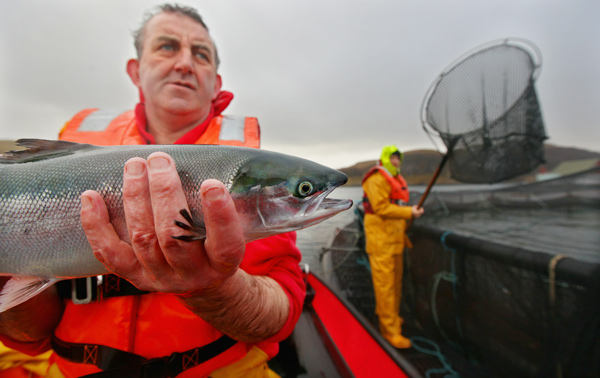Scottish salmon graces China dining tables
 |
|
John MacLeod, site manager at Scottish Sea Farms, Lismore North farm, holds a salmon in Oban, Scotland. JEFF J MITCHELL / GETTY IMAGES |
China has a fast-growing appetite for fresh and smoked salmon, but Scotland's fish farmers have been struggling to keep up with demand from the lucrative market.
Scotland is one of the world's major suppliers of farmed salmon, but the industry's growth was recently hampered by sea lice infestations that led to a drop in production. Sea lice are a parasite that latches onto fish, seriously affecting their growth.
Figures from the United Kingdom's HM Revenue and Customs showed the export volume of salmon to China fell from around 11 million kilograms in 2015 to 8 million kg last year, something the industry attributed to the sea lice outbreak. In 2014, some 13 million kg of the pink-fleshed fish were shipped to the world's second-largest economy.
Despite the fall in exports to China, the value of the industry remained high. In 2016, the value of salmon exports was around 52 million pounds ($67 million). In the previous year, it was 53 million pounds.
Beijing first allowed imports of Scottish salmon in 2011.
Scott Landsburgh, chief executive of the Scottish Salmon Producers Organization, said: "Sea lice are nothing new, they exist in the wild and climate change is contributing to the spread. The industry has invested tens of millions of pounds on research and development of new techniques and equipment.
"I'm confident we are on top of the issue and will be able to supply really high-quality, healthy fish to the Chinese market," Landsburgh added.
Landsburgh attributed the fall in exports entirely to the early harvest.
"China likes larger fish, around 7 kg, but there was an early harvest last year in order to provide healthy and high-quality salmon, which resulted in smaller fish. That is why exports to China dipped a bit in 2016."
But Landsburgh expects business to pick up this year and anticipates increased productivity in the years to come.
JD.com Inc, one of the largest e-commerce operators in China, said a majority of Chinese consumers are willing to buy fresh products online, and seafood products are among the most popular categories. Shrimp, fish and other seafood are quite well-received, especially those who come from the inland regions.
Du Ni, a 27-year-old office worker in Beijing, said: "I like salmon, it is really fresh and tasty. I sometimes buy imported salmon from supermarkets, and at other times eat it at restaurants."























